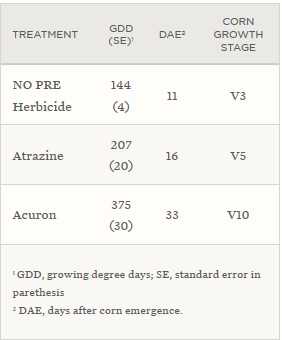May 14, 2018

Source: University of Nebraska-Lincoln
By O. Adewale Osipitan and Stevan Knezevic
Widespread and repeated use of glyphosate in Roundup Ready crops has resulted in 17 weed species becoming resistant to glyphosate in the US, confirmed as of 2017. At least six of these species are in Nebraska. These numbers reinforce the need to diversify weed control programs to reduce reliance on glyphosate.
We hypothesized that the use of preemergence (PRE) herbicides would delay the first (and possibly only) application of glyphosate; however, we did not know the extent of the delay. Therefore, we conducted an experiment at Concord in northeast Nebraska in 2017 to evaluate the influence of PRE herbicides on the critical time for weed removal with glyphosate in Roundup Ready corn. Three herbicide regimes — no PRE and PRE applications of Acuron® and of atrazine — were compared.
Acuron® contains four active ingredients: atrazine, bicyclopyrone, mesotrione, and s-metolachlor. Acuron was applied at 3 quarts/acre, while atrazine was applied at 2 quarts/acre, immediately after planting corn. Weed removal timings with glyphosate were: 3rd (V3), 6th (V6), 9th (V9), 12th (V12), and 15th (V15) corn leaf stages. There were also season-long weed-free and weedy plots. The predominant weed species were common waterhemp, velvetleaf, and green foxtail (see Figure 1).
Results
The critical time of weed removal with glyphosate was delayed when PRE herbicides were used (Figure 2).
Critical period of weed control (CPWC): The time in the crop growth cycle when weeds must be controlled to prevent yield losses.
Weeds that emerge before or after this period may not present a threat to crop yields.

Figure 2: Corn yield loss as influenced by three herbicide treatments: No-PRE, atrazine and Acuron
Based on a 5% acceptable yield loss threshold, the critical time for weed removal ranged from 144 to 375 growing degree days (GDD) which corresponded to the V3, V5 and V10 corn growth stages, depending on the herbicide regime (Table 1).
Table 1: Critical time of weed removal in corn based on 5% yield loss with and without PRE herbicide.

For example, without PRE herbicide, the critical time of weed removal started at V3 growth stage, while with PRE application of atrazine, the critical time was delayed to the V5 growth stage. PRE application of Acuron® further delayed the critical time of weed removal to the V10 growth stage, which was approximately six days to time of corn canopy closure.
Weeds that emerge past the time of canopy closure are typically not competitive enough to impact corn yields. Therefore, we confirmed that PRE herbicides delayed the need for POST application of glyphosate and also provided alternative modes of action for fighting glyphosate-resistant weeds in corn.
You May Also Like




